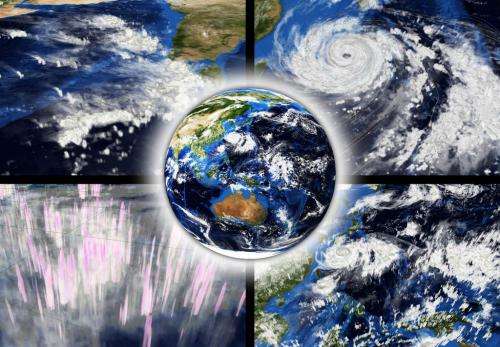Researchers improve simulations of deep moist convection to accurately predict effects of climate change

Simulations of deep moist convection need to be run at grid resolutions finer than 2 kilometers to accurately predict the effects of climate change.
Deep moist atmospheric convection controls the development of major weather systems like hurricanes, drives the global transport of energy within the climate system and strongly influences the uncertainty of projected climate change. As computational power advances, the direct simulation of cloud processes within climate change models is on the horizon. Yoshiaki Miyamoto, Hirofumi Tomita and their colleagues from the RIKEN Advanced Institute for Computational Science reveal that in order to realistically simulate the critical features of cloud convection, models will ultimately need to be run at a grid resolution no coarser than 2 kilometers.
Unless cloud simulations improve, uncertainties will remain unacceptably high for many pressing topics, such as the response of regional precipitation and global mean temperature to increases in greenhouse gas concentrations. Yet despite decades of research, the role of clouds in a changing climate remains unclear, largely reflecting a disconnect between cloud processes operating at the scale of individual water droplets and the 50- to 100-kilometer resolution used in many simulations of future climate.
Miyamoto and his colleagues showed that an intermediate resolution can be used to drive deep moist convection, thus providing a clear target for future climate model development. The team simulated 12 hours of global cloud processes with the Nonhydrostatic ICosahedral Atmospheric Model (NICAM) at a range of grid spacings of 0.87 to 14 kilometers. They found that simulations at 0.87 kilometers resolved deep moist convective processes ranging from individual subkilometer convective cells to the detail of tropical cyclones spanning hundreds of kilometers (Fig. 1).
At resolutions coarser than 2 kilometers, crucial cloud features were lost. "In the real world, convection is intensely variable and clouds have wide gradients in water vapor density and vertical velocity," says Miyamoto. "Coarser grids create unrealistically sharp transitions in cloud properties, with negative consequences for the realistic representation of related processes like condensation and precipitation."
New theoretical insights could also arise from the team's work. "Our finding that convective features change drastically at resolutions of 2 kilometers or more opens up new avenues for research into the interactions between convection and global atmospheric circulation that would have been invisible at coarser resolutions."
Hitting the 2-kilometer target will be a challenge. Even with ever-expanding computational power, 2-kilometer simulations of climate for a period of a few years, let alone the next century, are probably a decade or more away. Another option, according to Miyamoto, would be to simulate a limited area at a 2-kilometer spacing within a coarser global grid.
More information: Miyamoto, Y., Kajikawa, Y., Yoshida, R., Yamaura, T., Yashiro, H. & Tomita, H. Deep moist atmospheric convection in a subkilometer global simulation. Geophysical Research Letters 40, 4922–4926 (2013). dx.doi.org/10.1002/grl.50944
Journal information: Geophysical Research Letters
Provided by RIKEN


















